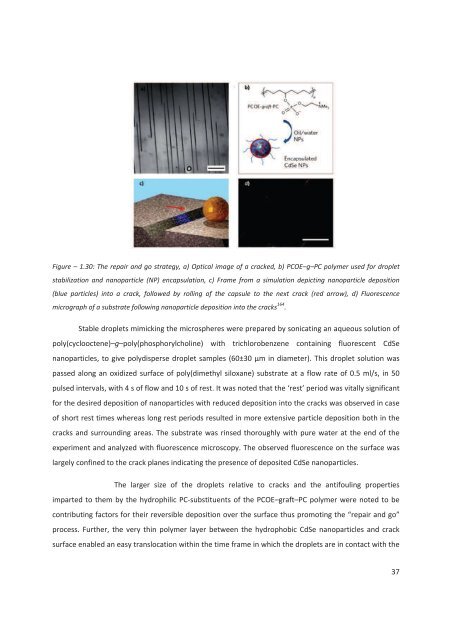4(%3)3 - Ecole nationale supérieure de chimie de Montpellier
4(%3)3 - Ecole nationale supérieure de chimie de Montpellier
4(%3)3 - Ecole nationale supérieure de chimie de Montpellier
You also want an ePaper? Increase the reach of your titles
YUMPU automatically turns print PDFs into web optimized ePapers that Google loves.
Figure – 1.30: The repair and go strategy, a) Optical image of a cracked, b) PCOE–g–PC polymer used for dropletstabilization and nanoparticle (NP) encapsulation, c) Frame from a simulation <strong>de</strong>picting nanoparticle <strong>de</strong>position(blue particles) into a crack, followed by rolling of the capsule to the next crack (red arrow), d) Fluorescencemicrograph of a substrate following nanoparticle <strong>de</strong>position into the cracks 164 .Stable droplets mimicking the microspheres were prepared by sonicating an aqueous solution ofpoly(cyclooctene)–g–poly(phosphorylcholine) with trichlorobenzene containing fluorescent CdSenanoparticles, to give polydisperse droplet samples (60±30 µm in diameter). This droplet solution waspassed along an oxidized surface of poly(dimethyl siloxane) substrate at a flow rate of 0.5 ml/s, in 50pulsed intervals, with 4 s of flow and 10 s of rest. It was noted that the ‘rest’ period was vitally significantfor the <strong>de</strong>sired <strong>de</strong>position of nanoparticles with reduced <strong>de</strong>position into the cracks was observed in caseof short rest times whereas long rest periods resulted in more extensive particle <strong>de</strong>position both in thecracks and surrounding areas. The substrate was rinsed thoroughly with pure water at the end of theexperiment and analyzed with fluorescence microscopy. The observed fluorescence on the surface waslargely confined to the crack planes indicating the presence of <strong>de</strong>posited CdSe nanoparticles.The larger size of the droplets relative to cracks and the antifouling propertiesimparted to them by the hydrophilic PC-substituents of the PCOE–graft–PC polymer were noted to becontributing factors for their reversible <strong>de</strong>position over the surface thus promoting the “repair and go”process. Further, the very thin polymer layer between the hydrophobic CdSe nanoparticles and cracksurface enabled an easy translocation within the time frame in which the droplets are in contact with the37











